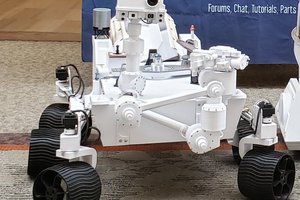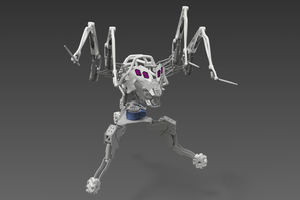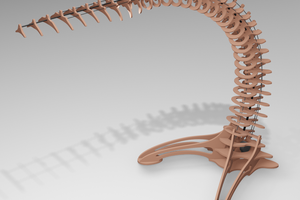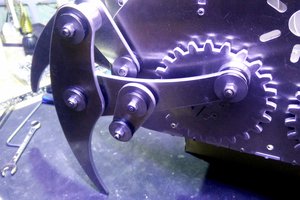Robotic Arm
A robotic arm with feedback to recreate your choreography.
A robotic arm with feedback to recreate your choreography.
To make the experience fit your profile, pick a username and tell us what interests you.
We found and based on your interests.
Bearing support printing.mp4The printing of the bearing supports v2.MPEG-4 Video - 1.29 MB - 12/19/2024 at 10:45 |
|
|
Bearing support printing.jpgThe printing of the bearing supports v2.JPEG Image - 115.00 kB - 12/19/2024 at 10:45 |
|
|
V2.4.jpgThe first version I made without the servos and the claw.JPEG Image - 190.41 kB - 12/19/2024 at 09:30 |
|
|
V2.3.jpgThe first version I made without the servos and the claw.JPEG Image - 173.33 kB - 12/19/2024 at 09:30 |
|
|
V2.1.jpgThe first version I made without the servos and the claw.JPEG Image - 211.40 kB - 12/19/2024 at 09:30 |
|
|
16/12: I had personal time so I decide to fix the arm to the circular platform I cut previously. I screw shelf brackets to the platform and the first part. I didn't add the holes when I laser cut the piece so I used a drill. It's not the best way but it worked.
9/12: I went to the Fablab on my personal time because I wanted to progress on my project. First of all I printed the bearing supports. I then had to break the old ones because I wasn't able to pull out the bearings. Once the printing was over, I put the bearings in and helped me with the vice. I had to print again one support because one of them broke when I tried to insert the bearing.
Once I had the four pieces done I worked on the axis. I had a 30cm steel shaft so I needed to cut it in half. I used a metal saw to trim it and then I filed the edges.
12/12: I worked on the construction of the arm. First, I cut in plywood the parts I modeled. Then, I started to assemble. I fixed the bearing supports on the structure as well as the axis support. I needed glue to fix the bearing to the shaft. I was able to build the first and second parts but didn't have time to build the third part nor the claw. I don't know if I'll be able to do it.
5/12: I had a very busy schedule so I lost focus. Plus, I started to procrastinate the assembly of my arm. Nevertheless, in a first time, I modeled the new bearing supports with adapted dimensions. I needed to reinforce the screw holes because they were too breakable. I also added a fillet on the top of the support to steer the bearing more easily. Because of the friction of the inside wheel of the ball bearing on the support, the bearing couldn't spin as well as it spun outside of the support. Therefore, when I modeled the piece, I didn't extrude the matter as much for the part in contact with the small wheel as I did for the part in contact with the larger wheel.
In a second time, I modeled the structure of the arm with holes to screw the bearing supports, the shaft supports and for the shaft.
28/11: I modeled new bearing supports with the correct dimensions (because I modeled a first version based on other bearings) and printed them. I had trouble to fit the ball bearings inside so I filed the edges of the holes and with the vice I finally made them fit. Unfortunately, the dimension were not so good for the screw holes and they were too breakable so I'll need to make modification.
20/11: I worked between two sessions because I'm behind the schedule. I needed to try the servos so I wanted to download the FE-SCPC-2 software. Unfortunately, I had issues to find it and I lost a lot of time. Once I got it I faced another issue: I didn't understood how it worked. I did some research but didn't find anything yet.
21/11: I worked on the mechanical part of the arm and searched the bearings, the shafts and the shaft supports I needed. I ordered the couplings to support the shafts and founded 8mm bearings in the Fablab. For the shaft, I did some calculations about pressure and decided that I will model it on Fusion 360. I also modeled a flange housing for the bearing.
07/11: The AX-12A Servos aren't available on the supplier website until mid December so I had to change my plan. Fortunately, I was able to find an alternative type of servos with an equivalent torque (Smart Servos SCS15). However, even if I had the servos I needed some components to control it so I did some research about the utility and the operation of those components.
I also realized I was late on the schedule. Consequently I will have to work more outside of the class time.
25/10: I created a connection between two parts with 2 ball bearings and a shaft but at the end I realized that it will not be possible to be hand directed because of the bearings on the part that is supposed to move. The solution turned out to be the use of a coupling instead of the ball bearing. It has to be fixed on the shaft and on the moving part.
17/10: I laser cut the parts I modelled for the version 1 of the arm. The modeling was made on Fusion 360 and the material for the cutting is 3mm plywood.
I then started to work on the mechanism of the arm. The first objective is to be hand directed so I had to think about the different connections needed. I started to work on the 'shoulder' connection. The solution I came with was to use gears, bearings and a shaft to connect the two parts together so I search the different types I could use for my project.
10/10: It was the start of the practice. To determine how many motors I needed and detect the potential problems I created a cardboard prototype of the arm. I conclude that I needed 4 servos (3 for the axis of freedom, 1 for the clamp).
I also did some research on the servos (the torque needed, the precision) and decided to use the AX-12A Dynamixel Servos.
03/10: I started my research with some design inspirations and videos of engineers doing their own robots like Jeremy Fielding. I had issues to understand technical parts and to know how and where to start because I had limited knowledge. However, I knew it was normal and the only way to understand was to carry on the work and start the practice part.
Create an account to leave a comment. Already have an account? Log In.
Become a member to follow this project and never miss any updates

 lmckeega
lmckeega
 Val
Val

 Pinomelean
Pinomelean